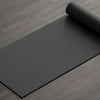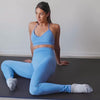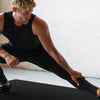What Do You Need for a Home Gym? Essential Equipment & Setup Guide
Ever stood in your living room, staring at that lonely resistance band draped over your TV stand, wondering why your "home gym" isn't exactly delivering those promised results? Been there! That sad little corner with a single kettlebell and a rolled-up yoga mat isn't cutting it—but don't worry, creating a functional home workout space doesn't require a mansion or a bank loan!
Let's get real about what you actually need to build a home gym that you'll use consistently (because that's the whole point, right?). After watching countless workout spaces transform from cluttered afterthoughts to motivational powerhouses, I've learned exactly what works and what's just collecting dust.
Ready to create a home gym that you'll actually use? Let's dive into what you really need (and what you can absolutely skip).
Building a Home Gym: Key Points
These are the equipment I started with and absolutely recommend:
-
Start by choosing the right space at home. Consider ventilation and flooring.
-
Invest in Long Gym mats from SENSU
-
Dumbbells and Kettlebells
-
Resistance Bands
-
Adjustable bench
-
Cardio Equipment (Treadmill, Stationary Bike, or Jump Rope)
-
Optionals such as Mirrors, Storage Racks, and Bluetooth Speakers for Motivation
What Do You Need For A Home Gym? Full List and Review
1. Choosing the Right Space for Your Home Gym
Just having a space doesn’t mean you have enough space.
I’m always surprised by how many people tell me they want to work out at home, but their setup consists of just one kettlebell, a medicine ball, and a mat squeezed next to their washer and dryer.
Honestly, that’s not enough for an effective workout.
Ideally, your workout space should be:
-
Separate from your main living area. In my home gym, I sectioned off part of my basement.
-
Inspiring. If possible, hang up posters of people who motivate you.
-
Have windows or fans for natural airflow (especially if you’re using a basement, garage, or small room)
2. Gym Mats
Once you’ve chosen your home-gym space, the first thing to do is pad it up like a real gym. Good flooring protects your joints, equipment, and the surface underneath.
If you need more floor cushioning but don’t need a whole other set of puzzle-mat pieces, this yoga mat works great.
QUICK TIP:
-
When choosing a workout mat for your home gym, focus on key features like thickness, lightweight, sweat resistance, and easy cleaning.
If I were to recommend one, it would be the mat I currently use from Sensu, which has earned high scores for design, comfort, grip, and portability.
BEST MATS FOR HOME GYM: SENSU LARGE EXERCISE MAT
|
6' x 4' Sensu Gym Mat |
7' x 5' Sensu Gym Mat |
|
|
Length |
72 inches |
84 inches |
|
Width |
48 inches |
60 inches |
|
Material |
With antimicrobial properties |
With antimicrobial properties |
|
Thickness |
8.5mm |
8.5mm |
|
Height suitability |
Up to 5 ft 6” tall and above |
Up to 6ft tall and above |
|
Price |
$130 |
$190 |
|
Where to buy |
Buy Sensu Extra large yoga Mat |
Buy Sensu Large Exercise Mat (with Money Back Guarantee) |
Many home gym enthusiasts consider the Sensu Exercise Mat as the perfect pick because it stays in place and lasts well beyond a year.
I’ve used thin workout mats before, so the difference was immediately noticeable when I switched to Sensu Yoga Mats. These mats are extra thick and incredibly dense, offering a superior experience.
QUICK NOTE BEFORE YOU BUY THESE MATS FOR HOME GYM:
-
These mats aren’t the interlocking types you’d find in gyms or CrossFit boxes. Instead, they’re ideal for home workouts like cardio or weight training.
2. Kettlebells and Dumbbells
The kettlebell might look like a heavy, awkward ball of steel, but it’s designed to be swung, lifted, and even held overhead like a wiggly toddler.
Amazon offers its own version in sizes ranging from 10 to 60 pounds. I personally use a 45-pound kettlebell and love doing the classic swing between my legs.
QUICK TIP:
-
Use your hips and legs to power the movement, rather than my arms and shoulders. It will help you keep good form and avoid injuries.
For dumbbells, a good beginner-friendly option for a home gym is an adjustable set that ranges from 5 to 20 pounds. This allows you to gradually increase weight as you get stronger while also having lighter options for high-rep exercises.
If you prefer fixed-weight dumbbells, consider getting pairs of 3-5 pounds, 8-10 pounds, and 15-20 pounds, depending on your strength level.
For a basic home gym setup, having at least one pair of 5-pound, 10-pound, and 15-pound dumbbells is a solid starting point.
3. Resistance Bands
Resistance bands can be just as effective as weights when it comes to building strength.
They create enough resistance to challenge your muscles during exercises, helping you get stronger over time.
One of the best things about resistance bands is that they’re much more affordable than traditional weights.
If you’re new to strength training, they’re a great way to start without spending too much money. In fact, trying out a bicep curl with a resistance band first can help you decide if you even need dumbbells.
Another big plus? They’re lightweight and don’t take up much space, making them easy to store. This is perfect for small apartments or home gyms.
QUICK TIP:
-
You can save big on resistance bands when you buy the 9-in-1 Foam Roller Set from Sensu which includes a set of 3 resistance bands—lightweight blue (10–15 lbs.), mediumweight yellow (15–20 lbs.), and heavyweight red (25–30 lbs.) to feel a burn or stretch you wouldn’t believe.
4. Adjustable Bench
If you’re serious about setting up a home gym, a bench is a must-have for using your dumbbells effectively.
The good news is, benches don’t take up much space, so you can fit one into almost any room.
A quick search online will show plenty of options. It’s better to choose one that can be adjusted to five different positions or more.
5. Cardio Equipment (Treadmill, Stationary Bike, or Jump Rope)
Treadmill is another solid investment if you’re building a home gym. But it may not be so necessary for a start.
It’s surely one to get if you need to engage your legs, core, and even arms (if you pump them while running)
If you have joint pain, the treadmill allows you to walk instead of running, which is easier on your knees compared to outdoor pavement..
You can walk at a slow pace or sprint, and some treadmills have incline settings to mimic uphill running for more intensity.
QUICK TIPS:
-
If you’re buying your first treadmill, get a foldable treadmill for space concerns. Also, check for shock absorption features to reduce impact on your joints.
-
Look for one with pre-set workout programs to make your sessions more engaging.
STATIONARY BIKE
A stationary bike is relatively costly but great if you want a solid cardio workout without putting too much strain on your joints. Unlike running, cycling is low-impact, making it ideal for people with knee or back issues.
JUMP ROPE
If you want a cheap but highly effective cardio tool, a jump rope is unbeatable. It costs way less than a treadmill or bike.
You can use it anywhere and store it easily. Also, a 10-minute jump rope session burns as many calories as 30 minutes of jogging.
6. Additional Accessories for a Complete Setup
Other items such as:
-
Mirrors
-
Storage Racks
-
Bluetooth Speakers
…aren’t must-haves, but they improve your gym. If space and budget allow, get at least a mirror and a speaker—they make a big difference.
A large mirror helps you check your posture and avoid injuries. It also makes your gym space feel bigger and brighter.
A small rack keeps your dumbbells, resistance bands, and towels in one place. This prevents clutter and makes workouts smoother.
Music or podcasts keep you pumped and focused. A good Bluetooth speaker gives clear sound, so you stay energized while working out.
Budget vs. Premium Home Gym Setups
The best setup for your home gym depends on your fitness goals and experience.
A basic yet effective setup includes an exercise mat, squat rack, an Olympic bar, a bench, and a good set of weight plates. This combination allows you to train all major muscle groups.
FOR BUDGET
If you’re on a budget, consider looking for second-hand equipment through auctions or resale websites instead of buying brand-new gear.
While there are plenty of high-quality fitness machines available, they can be expensive. That’s why having a workout plan matters.
THINK THIS BEFORE BUYING THE HEAVY STUFF
For example, buying an expensive treadmill doesn’t make sense if you rarely run, and spending big on a stationary bike isn’t worth it if you can’t stand long cycling sessions.
If you’re trying a new type of workout, start with a budget-friendly option before spending a lot on premium equipment. This way, you can test if you enjoy the exercise without a huge financial commitment.
Final Thoughts
There are plenty of other things you can add to your home gym, like a dip bar attachment, kettlebells, dumbbells, or even a punching bag.
These can all be great additions and might actually be more useful than a bench, which some people find overrated.
That said, if you focus on the six key pieces of equipment mentioned earlier, you’ll already have everything you need to build strength, improve fitness, and stay healthy. In fact, for many people, these basics might be all they ever need.






